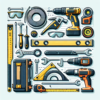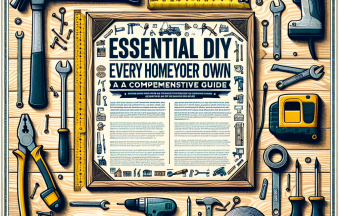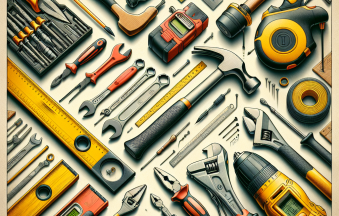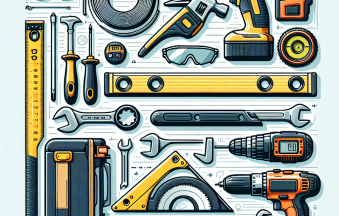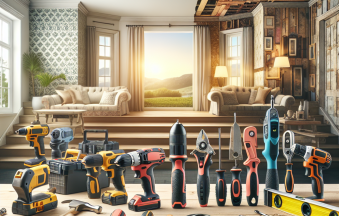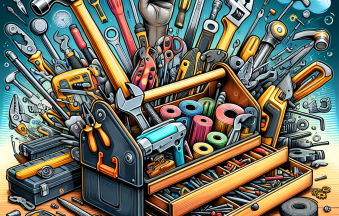Initiating a home enhancement endeavor can be an exhilarating experience. Whether you’re an experienced DIY enthusiast or just entering the realm of home repairs, possessing the correct tools is vital. In this guide, we’ll delve into different categories of DIY tools that can streamline your tasks and increase your enjoyment.
Home Tools: The Cornerstone of DIY Achievement
Home tools consist of a variety of instruments crafted to facilitate repairs and upgrades. Fundamental items such as a cordless drill, screwdriver kit, and handsaw are essential components in any toolkit. A cordless drill, specifically, is adaptable for creating holes, assembling furniture, or even driving screws.
Construction Materials: The Support System of Your Undertakings
It’s impossible to erect a sturdy framework without high-quality construction materials. This category covers everything from lumber and plywood to soil and aggregate. It’s important to comprehend the various material types available and their specific uses. For example, if you’re building a deck, pressure-treated wood is an excellent option due to its durability and resistance to rot.
Where to Begin?
When selecting construction materials, reflect on your project’s extent and the necessary resources. Always seek advice from a specialist if you have uncertainties regarding what fits your requirements best.
Electrification Tools: Energize Your Projects
Safety is paramount when dealing with electrical components. Acquiring basic electrical tools is imperative, including wire cutters, circuit testers, and voltage readers. If you’re undertaking straightforward tasks such as substituting outlets or setting up light fixtures, these instruments will be quite useful.
Electrical Safety Guidelines
- Always turn off the electricity at the circuit breaker prior to commencing any electrical work.
- Utilize insulated tools to avert electrical shock.
- If you’re uncertain, consult an electrician.
Fasteners & Hardware: The Small Elements That Matter
Don’t undervalue the importance of quality hardware and fasteners. Nails, screws, anchors, and brackets are the unsung champions of any DIY undertaking. A well-equipped toolbox with a variety of sizes for each type is crucial. For example, drywall screws are necessary for securing drywall, while wood screws are suitable for attaching wood pieces.
Kitchen & Bathroom: Tools for the Heart of the Residence
Your kitchen and bathroom may be the most visited areas of your home, so ensuring they are well-cared for is crucial. Think about acquiring tools like a cabinet scraper or a plunger for minor kitchen and bathroom fixes. Learning how to install plumbing fixtures or lay tiles can also greatly improve these spaces.
Common DIY Endeavors
- Updating cabinet hardware
- Installing a backsplash
- Replacing a sink faucet
Light Bulbs & LEDs: Illuminate Your Environment
With advances in lighting technology, LED bulbs are the preferred choice. They provide energy efficiency and longevity, resulting in considerable savings. Besides changing out bulbs, having a sturdy ladder and reach pole can help in safely accessing hard-to-reach fixtures.
Lighting & Fans: Create the Ambiance
Lighting and ceiling fans are fundamental for ambiance and comfort. If you plan to replace an outdated ceiling fan or install dimmable lights, a robust step ladder and essential electrical tools will guide you toward an upgraded space.
Selecting the Right Fixtures
Consider the dimensions and style of the room. For instance, a large fan is ideal for roomy living areas, while a sleek pendant light can enhance a snug kitchen nook.
Measuring Instruments: Accuracy is Essential
Precise measurements can make or break your project. Key measuring instruments include a tape measure, level, and square. Make sure to take your time with measurements; it’s often advised to “measure twice, cut once.”
Painting & Wall Materials: A Fresh Appearance
Painting is one of the most fulfilling DIY tasks. Having quality paintbrushes, rollers, painter’s tape, and drop cloths will make this job easier. Consider investing in a paint sprayer for larger projects, as it saves time and guarantees a smooth finish.
Advice for a Successful Paint Job
- Choose a paint suitable for the surface you’re addressing.
- Prepare your surfaces thoroughly for optimal adhesion.
- Employ painter’s tape to safeguard edges and achieve clean lines.
Equipped with the appropriate DIY tools and expertise, you’ll discover that nearly any project is within reach. Embrace the journey of creating, repairing, and beautifying your home with these essential materials. Enjoy your DIY adventure!





